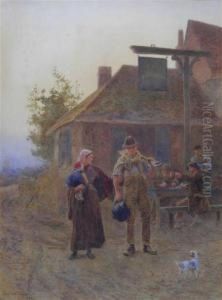Norman Tayler Paintings
Norman Tayler, born in 1823, was a British artist whose contributions to the art world, though not as widely recognized as some of his contemporaries, hold a special place in the annals of 19th-century British art. Tayler's life and career reflected the broader movements of Victorian art, as well as the shifts in taste and technology that characterized the era. His work is often noted for its meticulous detail, vibrant color, and the ability to capture the essence of his subjects, providing a window into the cultural and social dynamics of his time.
Tayler's early life was marked by a deep exposure to the arts, encouraged by a culture that was increasingly appreciative of the visual arts thanks to the efforts of art critics like John Ruskin. He pursued formal art education in London, where he was exposed to the works of the Pre-Raphaelite Brotherhood, a group that would greatly influence his style and thematic choices. Tayler's own work often echoed the Pre-Raphaelites' fascination with medieval themes, nature, and an attention to realism and detail that was revolutionary at the time.
Throughout his career, Tayler exhibited at various prestigious venues, including the Royal Academy of Arts, though he never became a member. His subjects varied widely, from portraits to landscapes, showing his versatility and keen eye for capturing the nuance of both human expression and the natural world. Despite his skills and contributions, Tayler never achieved the level of fame or commercial success of some of his peers, a fact that has led to him being somewhat overlooked in art historical narratives.
After his death in 1907, Norman Tayler's work fell into relative obscurity, overshadowed by the bold innovations of the early 20th century and the towering figures of the Victorian art world. However, recent reevaluations of 19th-century art have led to a renewed interest in Tayler's contributions. Today, his paintings can be seen as poignant reflections of Victorian society, noted for their technical proficiency, emotional depth, and the subtle critique embedded within the beauty of his compositions. Tayler's legacy, while quiet, endures as a testament to the richness and diversity of Victorian art, offering insights into an era that was at once deeply traditional and rapidly changing.
